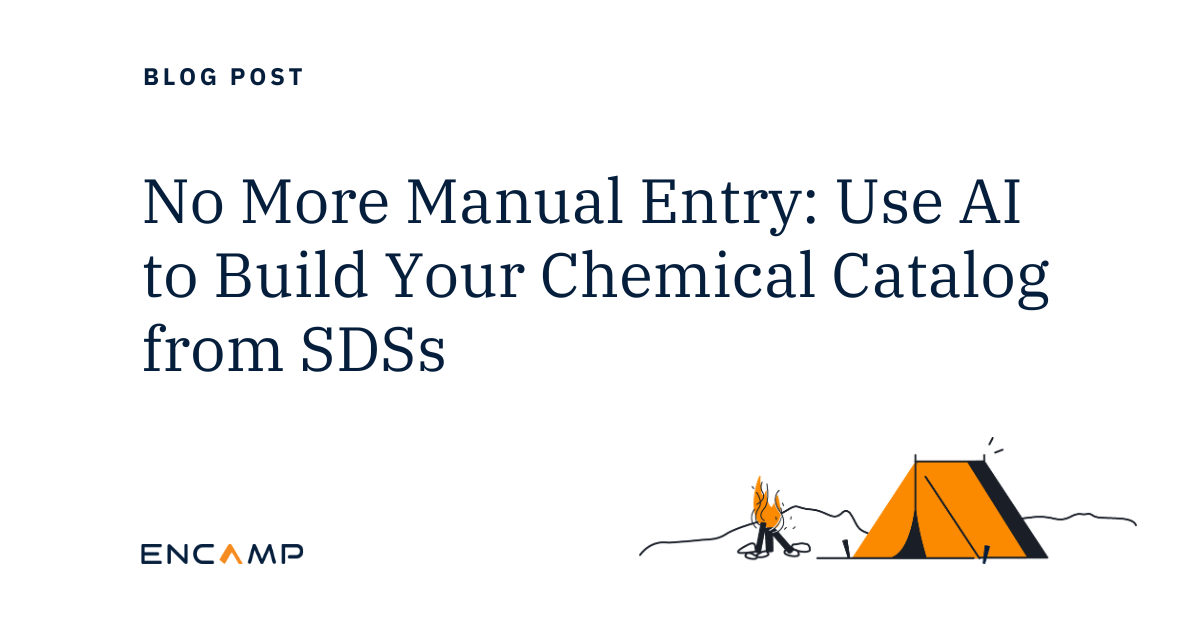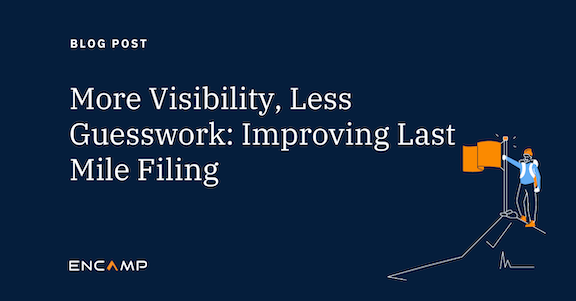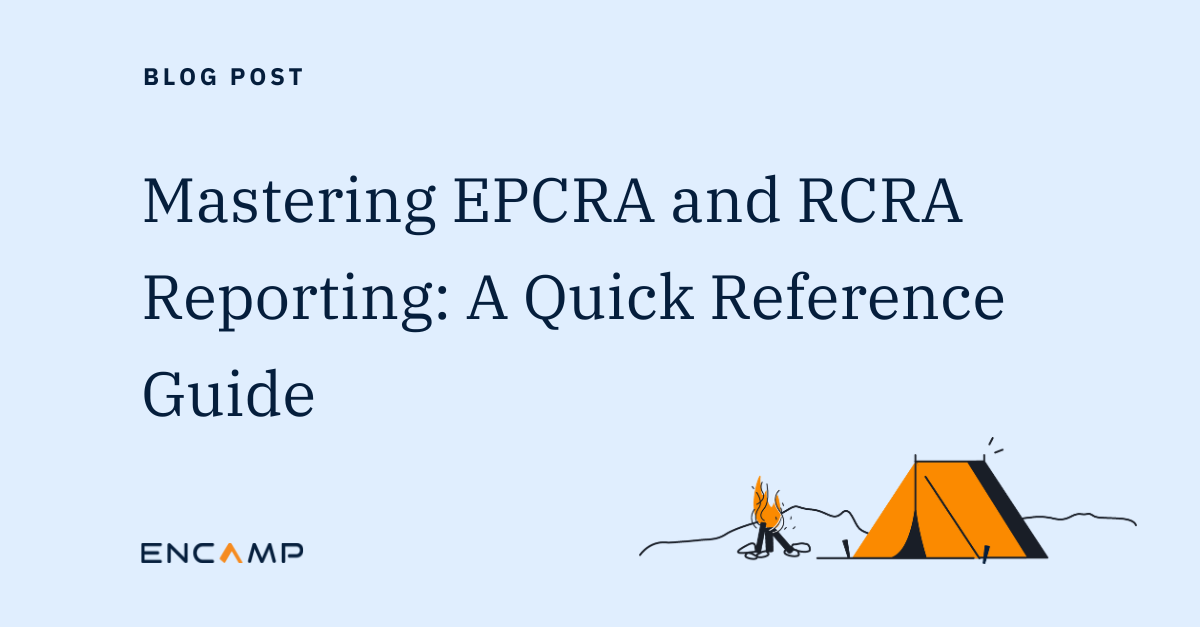Ask any EHS or Operations manager where Tier II reporting for EPCRA falls on their list of Favorite Things To Do, and they’ll probably tell you, “It doesn’t.”
Fair enough.
Before I came to Encamp, I was an Environmental and Product Safety Manager, and Tier II reporting was never something I looked forward to either. Why? EPCRA regulations to begin with. I had to know if facilities had to report (or not), then coax facility managers for reporting data and hope they could correctly identify chemicals and calculate quantities.
Then it was populating Tier II forms, by state, validating each report to make sure nothing got overlooked, navigating submission portals (by state, again), and paying all the filing fees.
For any EHS leader, Tier II reporting for 10 or 12 sites is manageable. Even in multiple states. But hundreds or thousands of sites across the country? Good luck. The problem isn’t just finding time to track down data and do reports. It’s making sure every report is complete and accurate, and doesn’t draw the attention of regulators for missing or incorrect information.
It’s the law
Like it or not for EPCRA compliance, Tier II reporting for hazardous chemicals is the law. There’s no legal option to avoid it or not comply. If you run the risk of non-compliance, the consequences can be severe. Think: financial penalties, shutting down a facility, or long-lasting damage to your company’s reputation.
It’s true that Encamp’s compliance management software really does simplify the Tier II reporting process. It even automates Tier II submissions for you to portals in all 50 states. But for those of us on the Customer Success and Compliance teams at Encamp, we come from environmental compliance backgrounds and know the pressures of submitting reports on time and with consistent levels of accuracy. Therefore, our aim really is to make Tier II reporting easier for you and keep it from disrupting your life for weeks on end.
From experience — and with empathies for everyone who currently manages Tier II efforts — here are eight tips (categorized accordingly) that can help you survive the trials of Tier II reporting.
Avoid common environmental compliance oversights
Tip #1: Make sure you have updated and GHS-compliant Safety Data Sheets (SDSs) prior to reporting season.
This is one of the most common errors we see in Tier II reporting every year. In line with the United Nations’ Globally Harmonized System of Classification and Labeling of Chemicals (GHS), OSHA’s Hazard Communication Standard (HCS) requires that any SDS “must be revised within three months after a chemical manufacturer or employer becomes aware of new information concerning the hazards of a chemical.”
Therefore per EPCRA regulations, make sure each facility required to report includes an updated SDS that meets GHS requirements. EPCRA further mandates that revised SDSs also be submitted to all agencies that have the original SDS. The sooner you do this, the easier the heavy lifting will be for Tier II preparations later on.
Two other helpful hints: Keep all SDSs in a single location, and minimize your number of suppliers whenever possible.
Tip #2: Confirm (and report) any short-term or seasonal chemicals onsite for projects, cleaning, temporary work, specialty products or R&D purposes.
Another common oversight is chemical data you wouldn’t normally think to capture. EPCRA Section 312 specifies that a business must account for any chemical present at a facility, for any given time during the year, that’s above the threshold planning quantity (TPQ) for an extremely hazardous substance. While a chemical might be onsite for only a short period of time, if it exceeds a state or federal threshold while at the facility, it must be reported. If you don’t, it’s a violation.
Stay aware of local Tier II reporting requirements
Tip #3: Know when additional City/County reporting requirements apply in states in which you maintain facilities.
Stay up to date with SERC and LEPC minutes that are applicable to your sites. (The EPA’s State Tier II Reporting Requirements and Procedures web page is a good starting point.) Also document — in detail — city/state nuances such as reportable quantities, reportable units of measure, and so on.
Gather Tier II data early
Tip #4: Don’t wait until the end of the year to start collecting compliance data.
For most companies, the Tier II reporting lifecycle largely falls into four segments: Data collection, data validation, data input, and data submissions. Especially for data collection and validation, a good rule of thumb is to have data ready to review the first week of January.
The list on the right is only an example lifecycle of data-oriented tasks, but it should give you an idea of what we mean by getting started “early.” (Note that we’ve added the months/ranges as a general timeline for when activities could take place.)
Data collection
- Outreach to sites/facilities (usually between July-November)
- Data collection and determining TPQs at each facility (this can include gathering purchasing records and other inventory information, too)
- Data collection returned for Tier II preparations (December)
Data validation
- Initial data validation (December-January)
Data input
- Data entry to state reporting (January – February)
- Data entry reviewed and signed
Data submissions
- Admin work completed (March 1 reporting deadline)
- Inventory management (302, 311, ongoing)
Go digital
Moving from spreadsheets and cutting-pasting information to managing data in digital format is a big jump. And whereas some companies and their EHS teams have made that jump via digital transformation, many others have yet to.
If you haven’t formally “gone digital” for your Tier II reporting tasks and processes already, you should still digitize compliance documents and EHS records at every opportunity. These can be purchasing records, inventory updates from the plant floor, SDS records, virtually any document tied to EHS Operations, compliance, and reporting.
Benefit-wise, digitization helps eliminate labor intensive manual work. When data is digitized, it’s efficiently maintained, easily located, and readily accessed — all electronically. Digitization is also key to these final four tips.
Tip #5: Keep site maps readily available, and update them when changes occur at your facility.
In general, the longstanding practice for facility site maps has been to just print out the map for each facility and clearly indicate the locations of all chemicals. Any changes in a facility’s storage location(s) or other requirements can trigger updates to the map, at which point the map gets printed out again and changes are marked up manually.
But digitize such maps, and changes can be made (and tracked) electronically — and far more efficiently. Also opposed to printouts in binders, digitized site maps are more readily available and accessible on a laptop or mobile device.
Tip #6: Keep an updated contacts register in a single location.
Keeping track of contacts information is usually mundane, manual work. So it isn’t surprising how often facility-level emergency contacts are overlooked, not updated, or not properly verified prior to submitting a Tier II report. When this information is maintained electronically, and especially in one place, it’s much easier to originate and update.
Tip #7: Ensure that all Facility Site Contacts have access to an electronic resource on the requirements of Tier II so they can keep you up to date on changes (consistent training).
In order to answer any questions from the SERC, LEPC, or local fire department, the contact person listed for a facility must be knowledgeable both about the chemicals onsite and the resulting Tier II report, its content and its accuracy. (Ok, this is where I make a pitch for Encamp). If you need access to a library of regular EPCRA and Tier II reporting requirement updates, the Encamp platform has the capability to let you verify their applicability for each specific facility. One of my colleagues also does nothing but track regulatory compliance updates in all 50 states, keeping your compliance top of mind.
Tip #8: Create a single source of truth for reporting and institutional knowledge.
Digital records can be centralized electronically in a single repository and made accessible to those who need the information via data networks, private clouds, or a SaaS-based platform. When EHS teams organize reporting data this way, it becomes seamless — making it easier to share data in a timely manner, minimize human error, conduct QC/QA processes, and generally maintain information year-round. Data becomes more “intelligent” and trusted, and stays ready for reviews as soon as the new calendar year begins.
(Read the Hexion case study to learn how they centralized data and Tier II reporting across their company and regional facilities.)
Transforming the way enterprises stay in compliance
Encamp is on a mission to create a world where good for business can equal good for the environment. We help enterprises transform compliance programs and human processes into a technology-driven system that lays the foundation for accurate and ongoing environmental compliance through a blended method of intelligent high-tech solutions and high-touch expert support.
Sam Schroeder
Sam joined Encamp in 2021 as a Customer Success Manager and, as she puts it, she’s “Customer obsessed and striving to make environmental compliance and reporting a breeze.” Her background in EHS lets her do just that, having served in various EHS and compliance management and consultant roles since launching her career in 2014.



